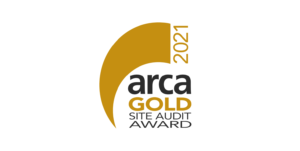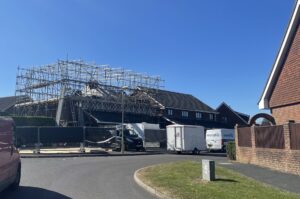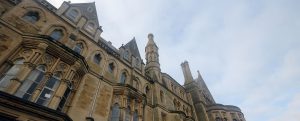When dealing with asbestos, trust in your removal contractor or surveyor is of the upmost importance. When removal works have been completed, the expectation of the building occupier should be that the job has been done accurately, leaving no residual contamination.
When asked to carry out an additional asbestos survey on a military site earlier this year, Merryhill obliged, but the outcome for the customer was surprising. As part of a complete building refurbishment, the only remaining area that required a survey was a small boiler room and disused riser. When the on-site contractor asked if this would be possible, our surveying team visited the site and took the necessary samples to ensure no residual asbestos was going to remain once it was all sealed. Upon inspection, our surveyors noticed some board at the top of the riser, but was unable to reach it using a ladder. Upon asking if there was access from above, they were then escorted to a plant room within the roof space. The required samples were taken and subsequently tested positive as being AIB, containing Amosite fibres. What the surveyor found whilst in the plant room were a number of sections of pipe lagging debris which they also suspected to contain asbestos. Further samples were taken and they too tested positive.
The findings alarmed the building manager as removal works had already been carried out in the plant room and the necessary compliance testing passed. A further inspection of the plant room by the surveyor highlighted a number of other areas where asbestos had been left as debris. Admittedly, the plant room was an awkward environment in which to clean with lots of equipment and restricted ceiling heights, but working procedures should have taken this into account. When working in restricted areas, particular care should be taken to fully remove all residue, especially in corners, behind pipes and under equipment. Once removal works have been carried out, a visual inspection is then used to spot any remaining debris as act accordingly. It would appear in this case, a visual check had not been done thoroughly enough.
The building manager had lost all faith in the previous attempts to remove asbestos and began to question other services such as surveys which had been carried out by the same supplier. Merryhill were asked to re-survey other sections of the building as a result and discovered even more residual asbestos debris.
Delight and disappointment were felt simultaneously by the building owner who subsequently had to pay for additional removal works, on top of the extra surveys. Not only did this put the refurbishment works back, but also ate into contingency budgets.
The moral of this story highlights the trust put in both asbestos removal contractors and surveyors by facilities managers and building owners. Had the boiler room not been surveyed and questions asked of the suspect top panel, then potentially many trade’s people could have been exposed to the residual asbestos found in the plant room, ceiling voids and radiator elements.
Besides the potential for lawsuits, morally, the job of an asbestos surveyor is to provide trust. Trust in the findings so that those responsible for a building can take the appropriate action. If this trust is broken, or there are any doubts as to the validity of the survey then the consequences can be huge.
Merryhill Asbestos Testing & Consultancy is separate company to Merryhill Envirotec and is a fully UKAS accredited practice offering both asbestos management and refurbishment and demolition surveys.





